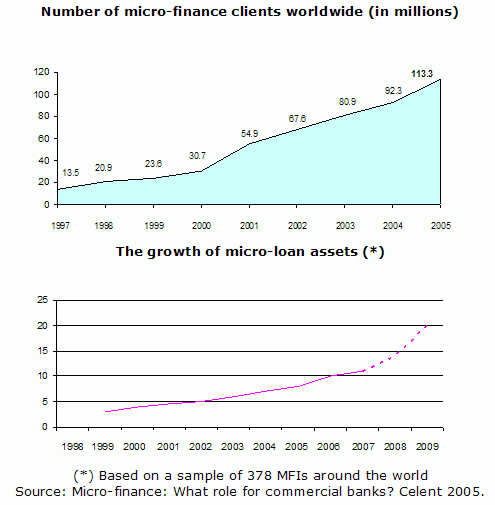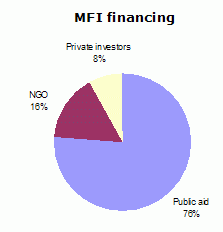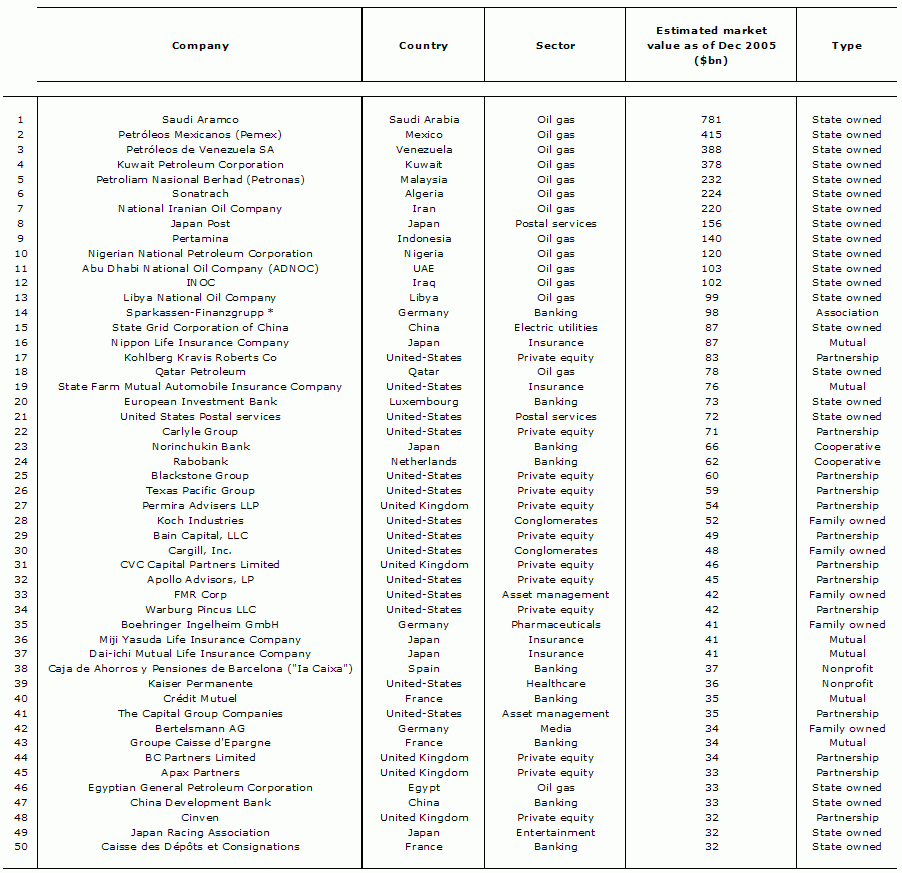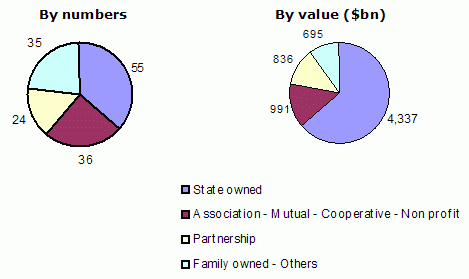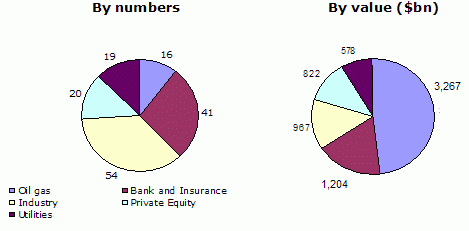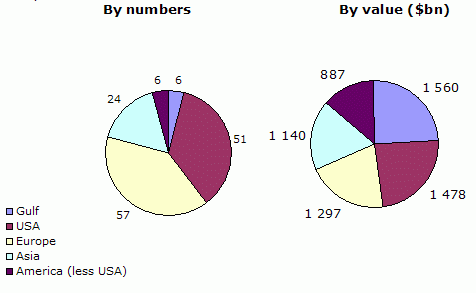Letter number 22 of January 2007
ALL ARTICLES
- TOPIC
- STATISTICS
- RESEARCH
- QUESTIONS & COMMENTS
News : Microfinance
The aim of all financial systems is to facilitate relationships between agents who have surplus capital at their disposal and agents in need of capital. It has been demonstrated that this function improves the general well-being of any society. On the whole, banks and financial markets fulfil this role very well by providing financing and/or investment opportunities to large numbers of corporations and ordinary people, especially in countries with western-style economies, but also in countries such as China, Turkey and the Gulf states.
Like any organisation, financial markets and banking systems have running costs (customer solicitation, analysis of loan applications, structuring of loans, providing of funds, management of repayments, bad debts and disputes). When these costs rise above a certain threshold, the intermediation service they cover becomes prohibitively expensive – we know of one financial intermediary that was asking for a fee equivalent to 80% of funds raised in an IPO of a firm with sales of €1.6m on the Paris OTC market!
So, there will always be some economic agents, the very poorest, who are de facto excluded from the official financial system which is just not interested in them. The paradox is that they are probably no less solvent in real terms than other borrowers and additionally, a portfolio of loans to the poor would be more diversified, and thus less risky (1) for investors. Muhammad Yunus, the founder of the Grameen Bank in Bangladesh, who was awarded the 2006 Nobel Peace Prize, has provided concrete evidence to confirm this.
It is true that the emergence of credit scoring techniques (2), followed by on-line borrowing over the Internet have helped to lower the breakeven point on loans, but there is a level below which the market system just cannot go. Also, not everyone has access to the Internet or to a long list of credit references.
Given this situation, the emergence of a financial system specifically tailored to meet the needs of potential borrowers who have always been ignored by the traditional financial system was inevitable. It is known as micro-finance. Originally, micro-finance was a specifically created financial system and not an extension of traditional services offered by banks. Banks had in fact always wrongly assumed that very poor borrowers would have a much higher than average loan default.
Micro-finance is thus aimed at people who do not have access to traditional financial system, in other words, at the very poorest members of society. This definition covers a large section of the population of emerging economies as well as the most underprivileged members of western societies. Micro-finance works on the basis of the same logic as the traditional system. The difference lies in the size of the loans granted. The average amount of a micro-loan in Asia or Africa is around €300 (and can be for as little as €10), in Eastern Europe it is usually just over €1,000 and in Western Europe around €2,500.
There are over 1,275 micro-finance institutions (MFIs) in the world that provide financing to over 100 million homes (3). The sector is experiencing strong growth, with a 10-fold increase in the number of borrowers in 10 years.
Micro-loans are generally used to finance small investments made by small businesses or rural homes. The loans are generally very short term (which limits the risk for the lender) but may be renewed, with the possibility of larger loans for responsible borrowers who meet their repayments. Often borrowers organise themselves into solidarity groups which enables them to guarantee the repayment of the loan.
Obviously, micro-finance does not purport to be able to solve all of the economic problems of emerging countries on its own. It is not the responsibility of MFIs to finance the infrastructure that is necessary for a country to develop. Micro-finance should thus complement other development initiatives. It is however undeniable that micro-finance helps to improve the living conditions of the very poorest members of society and to kick-start economic development.
The relationship between development aid and micro-finance is not that clear cut and defining micro-finance within traditional finance is not all that easy either. Even though recovery rates are very high (compared with recovery rates on traditional loans), operating costs of MFIs are, per euro lent, obviously much higher than for traditional loans:
- the number of loan applications to be processed is much larger
- provision of services is more complicated (widely dispersed populations, etc.)
So, notwithstanding relatively high interest rates (although much lower than interest rates charged by money-lenders and usurers), very few MFIs are profitable (around 200). A lucky thing it is then that most MFIs are not-for-profit organisations (associations and foundations)!
Most MFIs are financed by entities which are not required to be economically profitable such as governments (development agencies, etc.), international organisations (EU, World Bank, etc.) or NGOs. Traditional banks moving onto the micro-finance market generally have to sacrifice some of their profits which they justify on the grounds of corporate responsibility and ethics.
As some countries develop economically (this is especially the case in Latin America), MFIs are becoming more profitable and some even go as far as changing their status from not-for-profit organisations to traditional banks.
We could well see a natural shift from micro-finance to traditional finance and from traditional finance (banks) to micro-finance. Even though there are clearly links between the two (4), we do not believe that such a shift would be either natural or desirable.
Any attempt to be more profitable will have contradictory effects on the micro-finance sector:
- Greater financial efficiency for players, greater access to resources and accordingly greater involvement
- The solicitation of a more profitable client base (which will be more urban), with average loans for higher amounts, which would deny a section of the population access to financing
Even though attempts to achieve a certain financial independence (covering costs with interest made) could be a goal which would guarantee the continued existence of the system, the future of micro-finance is not to become part and parcel of the traditional finance system. Its future is to plough its own furrow by sticking to its initial aims and by continuing to assist individuals in a meaningful way (5) to “enrich themselves through their work and their savings (6)” (repaying a loan is a form of saving). Thanks to micro-finance, poorer clients can now hope that one day, they’ll be able to gain access to the traditional financial system with all of its advantages, although they will of course also have to accept all of its unavoidable running costs. In the long term, the best proof of the success of micro-finance will be its disappearance, when it eventually runs out of clients. Unfortunately, we may have to wait quite a while yet until that happens.
(1) For more information, see chapter 21 of the Vernimmen.
(2) For more information, see chapter 8 of the Vernimmen.
(3) Source: Micro-finance Information Exchange, figures are from 10,000 institutions and 130 million borrowers according to PlaNet Finance.
(4) The partial financing of micro-finance by institutions is a positive thing as it installs a sense of discipline in the management (especially of risk) and the reporting practices of these entities.
(5) For borrowers, this is not a grant or aid, but the provision of funds on better terms, for a service to which they would have had access had they been richer.
(6) François Guizot.
Statistics : The 150 largest non-listed groups
McKinsey and the Financial Times came up with the excellent idea of identifying the 150 largest non-listed companies in the world. The top 50 are reproduced in the following table:
Source : Financial Times (www.FT.com) and McKinsey.
Their total estimated value is close to $7000bn which is about the same as the market capitalisation of all companies listed on Euronext and the London stock exchange. McKinsey has computed their market value assuming that the companies have a capital structure and profitability similar to their listed peers. This explains why, for example, the European Investment Bank is valued at $79bn, i.e. with a PBR (1) of 2 whereas its ROE is only 5% before tax.
Most of them are state-owned companies:
50% of them are oil groups and they occupy 12 of the top 13 slots. Private equity funds are, by value, close to the total market value of industrial groups (which include everything but oil and gas, banking and insurance, and utilities). In addition KKR, Carlyle, Blackstone, Texas Pacific and Permira are bigger than the largest non-listed industrial group (Koch Industries).
Unsurprisingly, the Gulf is home to the largest number of the top unlisted companies:
(1) For more on PBR see chapter 28 of Vernimmen.
Research : Customers as shareholders of their suppliers
Customer-supplier relationships can take various forms, ranging from a simple over-the-counter transaction to vertical integration. Three US researchers (1) carried out an empirical study of factors that determine whether firms are likely acquire an equity stake in the capital of their suppliers. Their results confirm explanations provided by financial theory.
On the whole, it is relatively rare for firms to hold equity stakes in the capital of their suppliers. Only 3.31% of commercial relationships in the sample surveyed fell into this category. There are three factors that encourage firms to do so – the specificity of the investments, the intensity of the commercial relationships and the supplier’s need for financing.
Oliver Williamson, the father of transaction cost theory (2) explains that the degree of customer-supplier integration depends on the specificity of the investments. If a supplier makes investments, the results of which will only be of value to one of its customers, it would be in the best interests of this customer to own these assets in order to be in a position to provide the greatest incentives. In order to test this assumption, the authors looked at suppliers of products that required a lot of R&D and that were often highly specific. Their econometric work shows that integration is nearly three times more frequent for suppliers of R&D than for other suppliers.
The second explanation is the intensity of the relationship between a firm and its supplier. Unsurprisingly, a firm will acquire an equity stake in its supplier when it accounts for the largest share of the supplier’s sales. More interestingly, the existence of a formal commercial agreement in the form of a long-term contract also encourages firms to acquire equity stakes in their suppliers. These two ways of co-ordinating would thus appear to be more complementary than substitutable.
The third factor is the supplier’s need for external financing. The authors note that firms tend to acquire a stake in their suppliers more frequently when suppliers generate negative free cash flows (3) i.e., when their activity is insufficient to cover the cost of external financings. A good example is Ford’s support of the OEM Visteon, when it took a stake in the company through warrants in order to save it from bankruptcy, despite the fact that Ford had spun off its parts division to form Visteon only a few years earlier.
Finally, this study shows that although these three factors increase the likelihood of a customer taking a stake in the capital of a supplier, they do not cause any substantial increase in the size of the stake. In other words, the mere fact that a customer is a shareholder of its supplier is sufficient to ensure good co-ordination of investments, while the acquisition of an excessively large stake could lead to problems of corporate governance.
(1) C.E. Fee, C.J. Hadlock and S. Thomas, 2006, Corporate Equity Ownership and the Governance of Product Market Relationships, Journal of Finance, vol.61/1
(2) O. Williamson, 1975, Market and Hierarchies: Analysis and Antitrust Implications, The Free Press, New York
(3) For more on free cash flows, see chapter 2 of the Vernimmen.
Q&A : A small quizz (part II)
This is the second and last part of a quizz which first part was published in the previous edition of the Vernimmen.com Newsletter. Answers are given at the end.
16. The weighted average cost of capital of a diversified company is:
- identical for each of its divisions
- specific to each division and each geographical region
- the same regardless of geographical region
17. An increase in the share of debt in the financing of a company:
- reduces the cost of equity
- raises the company’s breakeven point
- lowers the beta coefficient of its shares
18. A company is more sensitive to changes in the economic situation if
- it is a long way from breakeven
- its fixed costs (as a proportion of total costs) are high
- it is carrying little debt
19. Who said “you can never spoil your shareholders enough"?
- John D. Rockfeller
- Albert Frère
- Warren Buffett
20. Which of the following shares is the most volatile?
- Cisco
- Imperial Tobacco
- BNP Paribas
21. The interest rate curve in the USA is currently:
- relatively flat
- sharp and rising
- sharp and falling
22. The vertical integration of a company within its sector:
- has no impact on its working capital requirements
- reduces its working capital requirements
- increases its working capital requirements in relation to sales
23. The yield to maturity on a loan with an interest rate of 6% paid quarterly will be:
- 6%
- 6.14%
- 6.66%
24. The Macaulay duration of a bond is:
- equal to its modified duration
- inversely proportional to its modified duration
- proportional to its modified duration
25. If the spot exchange rate is €1 = $1.2700, if the 3-month interest rate on the dollar is 5.30% and if the 3-month interest rate on the euro is 3.60, then the forward dollar / euro exchange rate is:
- 1.2647
- 1.2753
- 1.2725
26. A tag along clause enables:
- a lender to enjoy the same guarantees as those granted to another lender on a subsequent loan
- a minority shareholder to sell his shares at the same price as the majority shareholder
- a majority shareholder to force minority shareholders to sell their shares when he sells his
27. The equity risk premium in Europe is around:
- 3%
- 4.5%
- 6%
28. In an LBO, the second lien is:
- more risky than the senior debt
- more risky than equity
- never used
Answers:
